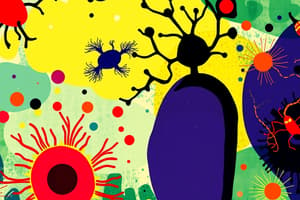Podcast
Questions and Answers
Who was the first person in history to view protozoa and bacteria called ANIMALCULES?
Who was the first person in history to view protozoa and bacteria called ANIMALCULES?
Antoni van Leeuwenhoek
Who developed the technique of vaccination to prevent smallpox?
Who developed the technique of vaccination to prevent smallpox?
Edward Jenner
Who advocated handwashing to prevent puerperal sepsis?
Who advocated handwashing to prevent puerperal sepsis?
Ignaz Semmelweis
Who is responsible for infection control and epidemiology?
Who is responsible for infection control and epidemiology?
Who disproved spontaneous generation?
Who disproved spontaneous generation?
Robert Koch was involved in research on all of the following topics except?
Robert Koch was involved in research on all of the following topics except?
What is the microbial production of alcohol from sugar known as?
What is the microbial production of alcohol from sugar known as?
Microorganisms characterized by the absence of a nucleus are called?
Microorganisms characterized by the absence of a nucleus are called?
The microbes commonly known as _____ are single-celled eukaryotes that possess no cell wall and are generally motile.
The microbes commonly known as _____ are single-celled eukaryotes that possess no cell wall and are generally motile.
Which of the following statements about fungi is false?
Which of the following statements about fungi is false?
Which of the following is not a characteristic of protozoa?
Which of the following is not a characteristic of protozoa?
Which of the following is NOT a characteristic of viruses?
Which of the following is NOT a characteristic of viruses?
Which of the following bacterial cell structures plays an important role in the creation of biofilms?
Which of the following bacterial cell structures plays an important role in the creation of biofilms?
Which of the following is (are) (a) magnifying lens(es)?
Which of the following is (are) (a) magnifying lens(es)?
All of the following are associated with smear preparation except?
All of the following are associated with smear preparation except?
What distinguishes bacteria from archaea?
What distinguishes bacteria from archaea?
What tells you how many protons are in an atom?
What tells you how many protons are in an atom?
The subatomic particles found in the nucleus of an atom are?
The subatomic particles found in the nucleus of an atom are?
What is matter composed of only one kind of atom?
What is matter composed of only one kind of atom?
Matter composed of two or more different kinds of atoms chemically combined?
Matter composed of two or more different kinds of atoms chemically combined?
What is the smallest unit of an element?
What is the smallest unit of an element?
What are two or more atoms chemically combined called?
What are two or more atoms chemically combined called?
Name an organic compound (must include carbon and hydrogen).
Name an organic compound (must include carbon and hydrogen).
PH is the measurement of the amount of hydrogen ions in a solution. As the concentration of ions increases, pH goes...
PH is the measurement of the amount of hydrogen ions in a solution. As the concentration of ions increases, pH goes...
What is the polymer to the monomer carbohydrate?
What is the polymer to the monomer carbohydrate?
What is the polymer to the monomer protein?
What is the polymer to the monomer protein?
What is the polymer to the monomer lipid?
What is the polymer to the monomer lipid?
What is the polymer to the monomer nucleic acid?
What is the polymer to the monomer nucleic acid?
A nucleotide molecule used for the temporary storage of high energy is?
A nucleotide molecule used for the temporary storage of high energy is?
Name a structure that is not a component of all cells.
Name a structure that is not a component of all cells.
The short, numerous appendages used by some bacterial cells for adhering to surfaces are called what?
The short, numerous appendages used by some bacterial cells for adhering to surfaces are called what?
The transfer of genes during bacterial conjugation involves rigid, tubular appendages called?
The transfer of genes during bacterial conjugation involves rigid, tubular appendages called?
What is composed primarily of phospholipids and proteins?
What is composed primarily of phospholipids and proteins?
Crenation, the shriveling of cells due to loss of water, occurs when cells are placed in what type of solution?
Crenation, the shriveling of cells due to loss of water, occurs when cells are placed in what type of solution?
Which of the following cell parts is mismatched with its function?
Which of the following cell parts is mismatched with its function?
What is a dormant, resistant cell formed during unfavorable conditions?
What is a dormant, resistant cell formed during unfavorable conditions?
Resolution is best described as?
Resolution is best described as?
What is the purpose of staining samples?
What is the purpose of staining samples?
In the binomial system of nomenclature, which term is always written in lowercase letters?
In the binomial system of nomenclature, which term is always written in lowercase letters?
If you have a sugar and water solution, sugar would be?
If you have a sugar and water solution, sugar would be?
What is not a passive process?
What is not a passive process?
What type of microscope would be most suitable for viewing a virus?
What type of microscope would be most suitable for viewing a virus?
Flashcards are hidden until you start studying
Study Notes
Microbiology Key Figures and Concepts
- Antoni van Leeuwenhoek: First to observe protozoa and bacteria, termed "ANIMALCULES".
- Edward Jenner: Pioneer of vaccination against smallpox.
- Ignaz Semmelweis: Introduced handwashing to reduce puerperal sepsis.
- John Snow: Father of infection control and epidemiology.
- Louis Pasteur: Disproved the theory of spontaneous generation.
- Robert Koch: Significant contributions to understanding anthrax, tuberculosis, and methods to prove infectious disease causation; he did not study fermentation.
Microbial Biology
- Fermentation: The process by which microorganisms convert sugar into alcohol.
- Prokaryotes: Microorganisms without a nucleus.
- Protozoa: Single-celled eukaryotes, motile, lacking a cell wall.
- Fungi: Eukaryotic organisms with cell walls, non-photosynthetic; molds form hyphae, and yeasts are unicellular.
Distinctions in Microbial Cells
- Bacteria vs. Archaea: Bacterial cells are unique for having peptidoglycan in their cell walls.
- Viruses: Acellular entities composed of genetic material and protein; invisible with a light microscope.
Bacterial Structures and Functions
- Glycocalyces: Structures essential for the formation of biofilms.
- Fimbriae: Short appendages aiding bacterial adherence.
- Sex pili: Rigid, tubular appendages for gene transfer during conjugation.
- Cell Membrane: Composed of phospholipids and proteins, forming a phospholipid bilayer.
Chemistry and Cell Biology
- Atomic Number: Indicates the number of protons in an atom.
- Elements: Pure substances consisting of only one type of atom; compounds are formed by two or more different atoms chemically combined.
- Monomers and Polymers:
- Carbohydrates: Monomer - monosaccharide.
- Proteins: Monomer - amino acid.
- Lipids: Monomer - glycerol and fatty acids.
- Nucleic Acids: Monomer - nucleotides.
- ATP: Nucleotide that serves as temporary energy storage.
Solutions and Cell Behavior
- pH: Measures hydrogen ion concentration; increases in concentration result in lower pH.
- Hypertonic solutions: Cause cell crenation (shriveling) due to water loss.
Microscopy and Staining
- Resolution: The ability to distinguish between two adjacent objects.
- Staining: Enhances specimen visibility and contrast.
- Transmission Electron Microscope: Best for viewing viruses.
Nomenclature and Cellular Processes
- Binomial Nomenclature: The specific epithet (species) is always lowercase.
- Solute: In a sugar and water solution, sugar acts as the solute.
- Passive vs. Active Processes: Bulk or group translocations are not passive.
Cellular Structures
- Endospores: Dormant, resistant structures formed under unfavorable conditions.
- Glycocalyx: Incorrectly associated with holding genetic information; it primarily serves protective and adhesive roles.
Studying That Suits You
Use AI to generate personalized quizzes and flashcards to suit your learning preferences.




